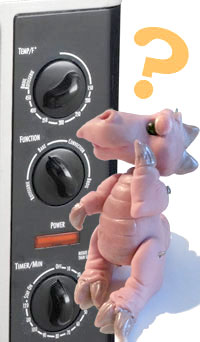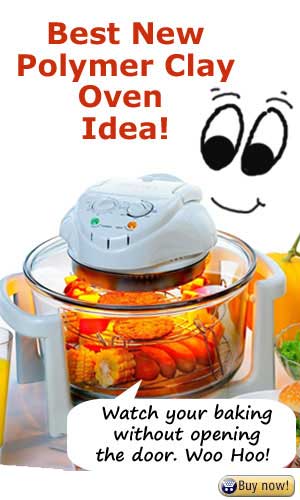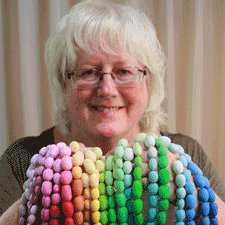Which Polymer Clay Oven Should You Buy?
Perfect Polyclay Baking Without The Worry
Are polymer clay oven reviews confusing you? Which type of clay craft oven bakes better, toaster, convection or microwave? What are the most important features?
Here's the answers plus three recommendations for 2021 models that will bake your Sculpey perfectly every time. And the best news is that you won’t have to take that long drove to Michaels or Hobby Lobby. Order them online and have them delivered right to your door.
There are many online
reviews and endorsements for ovens for baking polymer. Many date back to
the origins of the internet. Unfortunately, most of those models are
discontinued. However, the ones listed below are available right now.
- Sculpey Toaster Oven Review
- Countertop Toaster Oven or Microwave/Convection Models
- Newest Technology Countertop Type- infrared, halogen
- Baking Polymer Safely In Your Home Oven
So Which Polymer Clay Oven Models Are Best?
Well, it’s NOT a microwave oven. The only way that you can safely cure clay in a microwave is to submerge it in a container of water. And that really limits the size of your pieces.
The best oven is any one that holds a consistent temperature evenly for the entire baking process. There are few experienced clayers who will recommend Sculpey or Fimo baking in a small toaster oven, they’re too prone to temperature spikes.
Worried About Oven Temperature Spikes?
You should be. Once your polymer's scorched you can only cover it up or remove it. You can't undo it. So...
Use a good thermometer. Always. Set your clay craft oven to 200 degrees F (93 degrees C), let it warm up. Then put in your project. Let it bake for 10 minutes, then raise the oven temperature to the manufacturer's recommended baking tempurature and time for your brand of clay. Watch your oven thermometer like a Kardashian watches the tabloids. Be ready to yank your piece out if the temperature goes above 300F (150C).
Hamilton Beach Countertop Oven with Convection and Rotisserie

This Hamilton Beach ‘toaster oven’ workhorse has been very popular for a long time. They've been making this extra-capacity oven for years, and I find that reviews from the latest in 2021 show that the quality is still consistently good.
The San Diego Polymer Clay Guild purchased these for use at their wonderful annual retreat, Sandy Camp. For 4 days these ovens were used from dawn to almost midnight, sometimes longer. Ask me about my 1:00am baking and skunk adventure there!
Heather Kenney, one of the guild's ‘Oven Queens’ says, “We like it because it stays a consistent temperature and several of our members use this exact model at home including myself."
"We have used this model for the last seven years at least at Sandy Camp and have not had any issues with the ovens themselves. It has been getting harder and harder to find the black model for $82 and this last year I had to buy the silver model which was slightly higher in price but worked just as well.”
I like these clay craft ovens because they are BIG. You can fit two 9 x 13 inch baking pans on two adjustable, removable shelves. They usually don’t have ‘hot spots’. If you find that the one you have does, try using the convection setting to move the air around inside. Make sure you do several test bakes first with a couple of different oven thermometers before you try curing a significant project.
They have a temperature range from 150 - 450°F. And they are very accurate for such an inexpensive appliance. The fact that the oven has it's lowest setting point at 150°F rather than 200°F is great for those who love Fimo Professional clay which has a baking temperature of 230°F. It gives you a little bit of flexibility if you happen to get an oven that runs a bit hot. You can always turn the dial down a bit more.
Problems: 1) The numbers around the temperature setting dial are small. And 300°F is located directly below the dial. That means that the settings from 230° - 300°F which you'll be using to cure your clay may be hard to see.
2)The newest black models are lighter and not as well insulated. Give them some 'breathing space' and use heat protection if you have to move the oven when it's hot. Don't worry if you hear some interior metal flexing noises as they warm up or cool down. They still hold temperatures well.
The Fix: For the number settings, use a Sharpie to make a longer, more visible mark at the temperature(s) that you use the most often. Only do this once you've tested your new oven to make sure that it holds temperature accurately. Explaining why there's a big black line at 275°F might be difficult to explain to the manufacturer on a return form.
VERY IMPORTANT TIP: Only use the "Bake" setting on the Function Dial. People have reported scorching and burning on the other two settings.
Aside from those small drawbacks...
I love these ovens for baking polymer clay.
Sculpey Oven
You still may find these for sale on close-outs or clearance. It has been discontinued. And maybe it's for the best...
The official name of this toaster model is the Amaco Polymer Clay and Craft Oven. But everyone just calls it the ‘Sculpey oven’, when they aren’t calling it other names.
Not much has changed with this oven since I first reviewed it. It still has uneven quality. It still has a reputation for not maintaining a consistent oven temperature. And it is small. You only have 5 inches of baking room between the tray and the inside ceiling of the oven. Yes, it’s an inexpensive countertop option, but if you pay just a bit more for some of the other choices below you won’t be as limited or be as nervous when you bake clay. If your low budget is the problem, check out tips on how to bake safely in your kitchen oven below.
Secura Halogen Infrared Turbo Convection Countertop Oven
I"d really like my next portable clay day oven is going to be one of these space age looking infrared/convection tabletop models. Imagine being able to keep an eye on your thermometer and your project at all times! No more opening the door to check the thermometer because you can’t see inside the dark interior. No more worrying that your translucent Fimo is burning.
The best seller in this category on Amazon is highly rated, with many reviews but it has a plastic bowl and top. What’s good for poultry won’t work with polymer. Clear, hard plastics deteriorate quickly when they come in contact with raw clay plasticizers. So for an oven that will last, buy a model with a glass bowl and cover.
Sage Bray in "Baking With Light" in the Polymer Arts Magazine 2011|Edition 2 (buy this back issue at the link!) did testing on a halogen oven with a glass bowl. Here's what she found:
- The halogen oven that she tested was more energy efficient, and held a more consistent temperature with no 'spiking' than toaster or convection ovens.
- Test with an accurate oven or digital thermometer to see how long it takes to reach the correct polymer clay curing temperature at the bottom of the glass bowl. Make a note of this. For her infrared oven it only took 6 minutes.
- Take away the top rack and just bake on the bottom rack. The top rack can be 30 degrees hotter than the bottom.
- To avoid heat loss and burning your hands on the sides of the glass bowl, put your pieces in the cold oven then bring it up to the correct curing temperature. Just add the heating time to the standard baking period.
Most of the complaints about these ovens on Amazon concern the halogen bulb burning out or breaking. I suspect that polymer clayers might have fewer problems with this because the material that we're baking does not spatter or splash and has minimal water vapor.
The Secura infrared/convection polyclay oven comes with baking racks, a pan and an extender which I’d use all the time. I just like the idea of keeping the heating element as far away from my project as possible.
If you still think you need to protect protruding parts that may be too close to the heating lamp, just put a little foil tent around your polymer. You can still see most of the piece to check it. But fasten it the tent down, some of these units have a fairly powerful convection fan and you don't want your foil blowing around.
Baking Clay in Your Home Oven
Isn't Polymer Clay Toxic?
NO. But monitor your oven temperature carefully. USE A GOOD THERMOMETER! Burning polymer clay releases hydrogen chloride gas, which is caustic and will burn your lungs (but is not exactly toxic). But polymer clay doesn’t burn until it reaches temperatures near 350°F (175°C).
Don’t eat or prepare food with utensils or appliances that have come into contact with raw polymer clay. It's not that it's any more toxic than other plastics you might eat off of, its just that it may be harder to clean depending on the surface treatment. Raw clay is not soluble in water, so it's not easy to clean. And you do want to keep food contact areas clean, right??
Polymer clay is not technically a toxic material. There are no known connections with cancer , contrary to some scary internet articles that you might have read. Phthalate esters, which were implicated in certain endocrine cancers, were removed from all polymer clays before 2009, when they became illegal to put into children's items in the United states.
The cheapest polymer clay oven choice is using the one that's built into your home kitchen.
Baking clay in your home oven is perfectly safe if you don't burn it. It also doesn't leave any residue on your oven's walls. It's not just me saying that, its the makers of Sculpey and Premo who have much better testing services and lawyers than I do. Read the Polyform Health and Safety FAQ page to get the straight answers.
But you or other members of your family may be sensitive to the smell of curing clay. So many of us that use our kitchen ovens to bake clay try to contain the smells.
There are many different methods. But the best and easiest one is to bake your piece inside a tightly sealed oven bag on a stiff cookie sheet. They are made of polyester or nylon and are resistent to heat usually up to 400 to 450 F (200 to 230 C).
All the odors are trapped inside (while technically not toxic they do smell a bit). When the cooking time is finished, take the cookie sheet outside your house and set it on a sturdy, non-flammable surface before you open the bag.
I usually bake in one of these ‘turkey oven bags’ (18 inches x 20 inches or 45.72cm x 50.8 cm). The same company on Amazon also has an 'ostrich oven bag' which is 30" x 48"(76.2cm x 121.92cm ) you'll need a BIG oven.
The bags are reusable as long as they don’t have holes in them. Do not use twist-ties with metal in them to seal up the entry hole as this can melt the bag. If you run out of the ties that come in the package, cut a half inch strip off the open end of the bag and use the long thin piece to tie the bag. Also keep the bag away from any heating elements or the oven sides so it doesn’t melt.
Even if part of your bag accidentally melts (usually because it got too close to a heating element) and you see a hole in it, your oven is still safe for cooking food right away.
10 Steps to Baking Polymer Clay Safely In Your Kitchen Oven
- Place one oven rack in the lowest holder and another just above that
- Put a pizza stone or ceramic tiles on the lower rack
- Pre-heat your oven to the correct temperature (check by using your separate oven thermometer!)
- Get a cookie sheet to support your piece - preferably one with a lip all the way around.
- Grab a turkey bag and put your piece inside the bag with any normal supports like fiberfill, folded paper, etc
- Blow a puff of air into it to inflate it slightly and seal up the bag using the closures or a piece of bag and place it on the cookie sheet.
- Put the cookie sheet on the middle rack oven away from the hot walls and ceiling. Bake for the normal time according to the clay's factory instructions
- Turn off oven
- Take cookie sheet and piece out of oven and go outside your dwelling into a well ventilated space - use your oven mitts!
- Open bag - Admire your beautiful work.
|
|
|
What’s your favorite polymer clay oven?
PolymerClayer › Oven Recommendations




